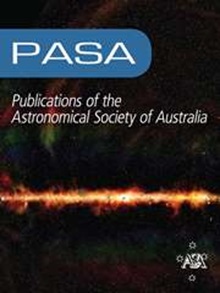WALLABY预试验调查:Eridanus超群的射电连续特性
IF 4.6
3区 物理与天体物理
Q1 ASTRONOMY & ASTROPHYSICS
Publications of the Astronomical Society of Australia
Pub Date : 2023-03-01
DOI:10.1017/pasa.2023.11
引用次数: 0
摘要
摘要利用ASKAP的广域澳大利亚平方公里阵列探路者(Widefield Australian Square Kilometer Array Pathfinder, ASKAP) l波段遗留全天盲测(Legacy sky Blind surveY, WALLABY)预导观测,获得了最高分辨率和灵敏度$ $1.4,$ GHz的Eridanus超群连续观测数据。我们在1.37 GHz下检测到9461个源,通量密度极限为0.1 mJy,分辨率为6.1”× 7.9”,中位数均方根为0.05 mJy束^{-1}$。我们发现通量尺度精确到5%以内(与1.4 GHz的NVSS相比)。然后,我们确定了在射电连续体和中性氢(HI)发射中检测到的8个Eridanus超群成员的整体特性,并发现射电衍生的恒星形成速率(SFRs)与先前的文献一致。利用我们在Eridanus附近星系的全局和分辨射电连续体特性,我们测量并扩展了红外射电相关性(IRRC),以较低的恒星质量和推断的SFRs。我们发现分解后的irc可以用于:(1)区分活动星系核和恒星形成星系;(二)识别本底射电源;(3)追踪ngc1385群环境预处理的影响。我们在ngc1385的HI、分辨光谱指数和IRRC形态中发现了潮汐相互作用和冲击压力剥离的证据。双叶射电喷流似乎与ngc1367中心的HI洞在空间上有重合(投影)。合并激波对多环芳烃的破坏可能是NGC 1359观测到的WISE W3赤字的原因。我们的研究结果表明,分辨射电连续体和IRRC研究是推动星系演化的物理过程的优秀示踪剂,并将在即将到来的ASKAP射电连续体调查的更大样本源上成为可能。本文章由计算机程序翻译,如有差异,请以英文原文为准。
WALLABY pre-pilot survey: Radio continuum properties of the Eridanus supergroup
Abstract We present the highest resolution and sensitivity
$\sim$
$1.4\,$
GHz continuum observations of the Eridanus supergroup obtained as a part of the Widefield Australian Square Kilometer Array Pathfinder (ASKAP) L-band Legacy All-sky Blind surveY (WALLABY) pre-pilot observations using the ASKAP. We detect 9461 sources at 1.37 GHz down to a flux density limit of
$\sim$
$0.1$
mJy at
$6.1''\times 7.9''$
resolution with a median root mean square of 0.05 mJy beam
$^{-1}$
. We find that the flux scale is accurate to within 5 % (compared to NVSS at 1.4 GHz). We then determine the global properties of eight Eridanus supergroup members, which are detected in both radio continuum and neutral hydrogen (HI) emission, and find that the radio-derived star formation rates (SFRs) agree well with previous literature. Using our global and resolved radio continuum properties of the nearby Eridanus galaxies, we measure and extend the infrared-radio correlation (IRRC) to lower stellar masses and inferred SFRs than before. We find the resolved IRRC to be useful for: (1) discriminating between active galactic nuclei and star-forming galaxies; (2) identifying background radio sources; and (3) tracing the effects of group environment pre-processing in NGC 1385. We find evidence for tidal interactions and ram-pressure stripping in the HI, resolved spectral index and IRRC morphologies of NGC 1385. There appears to be a spatial coincidence (in projection) of double-lobed radio jets with the central HI hole of NGC 1367. The destruction of polycyclic aromatic hydrocarbons by merger-induced shocks may be driving the observed WISE W3 deficit observed in NGC 1359. Our results suggest that resolved radio continuum and IRRC studies are excellent tracers of the physical processes that drive galaxy evolution and will be possible on larger sample of sources with upcoming ASKAP radio continuum surveys.
求助全文
通过发布文献求助,成功后即可免费获取论文全文。
去求助
来源期刊
CiteScore
5.90
自引率
9.50%
发文量
41
审稿时长
>12 weeks
期刊介绍:
Publications of the Astronomical Society of Australia (PASA) publishes new and significant research in astronomy and astrophysics. PASA covers a wide range of topics within astronomy, including multi-wavelength observations, theoretical modelling, computational astronomy and visualisation. PASA also maintains its heritage of publishing results on southern hemisphere astronomy and on astronomy with Australian facilities.
PASA publishes research papers, review papers and special series on topical issues, making use of expert international reviewers and an experienced Editorial Board. As an electronic-only journal, PASA publishes paper by paper, ensuring a rapid publication rate. There are no page charges. PASA''s Editorial Board approve a certain number of papers per year to be published Open Access without a publication fee.

 求助内容:
求助内容: 应助结果提醒方式:
应助结果提醒方式:


